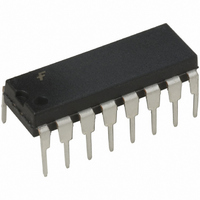DM9374N Fairchild Semiconductor, DM9374N Datasheet - Page 4

DM9374N
Manufacturer Part Number
DM9374N
Description
IC DECODER/DRVR/LATCH 7SEG 16DIP
Manufacturer
Fairchild Semiconductor
Series
7400r
Datasheet
1.DM9374N.pdf
(8 pages)
Specifications of DM9374N
Display Type
LED
Configuration
7 Segment
Current - Supply
50mA
Voltage - Supply
4.75 V ~ 5.5 V
Operating Temperature
0°C ~ 70°C
Mounting Type
Through Hole
Package / Case
16-DIP (0.300", 7.62mm)
Lead Free Status / RoHS Status
Lead free / RoHS Compliant
Interface
-
Digits Or Characters
-
Other names
DM9374
Available stocks
Company
Part Number
Manufacturer
Quantity
Price
Part Number:
DM9374N
Manufacturer:
NS/ه›½هچٹ
Quantity:
20 000
www.fairchildsemi.com
Applications
It is possible with common anode 7-segment LED displays
and constant current sink decoder drivers to save substan-
tial amounts of power by carefully choosing operating
points on display supply voltage. First, examine the power
used in the normal display driving method where the dis-
play and decoder driver are both operated from a 5.0V
regulated supply (V
The power dissipated by the LED and the driver outputs is
(V
a 15 mA LED displaying an eight (8) would be:
P
Of this 525 mW, the power actually required to drive the
LED is dependent on the V
GaAsP LEDs exhibit either a 1.7V or a 3.4V forward volt-
age drop. Therefore, the required total power for seven
segments would be:
P
P
The remaining power is dissipated by the driver outputs
which are maintaining the 15 mA constant current required
by the LEDs. Most of this power is wasted, since the driver
All Inverters are DTL 9936 or Open Collector TTL 7405
TOT
(1.7)
(3.4)
CC
x I
3.4V x 15 mA x 7
357 mW
5.0V x 15 mA x 7
525 mW
178.5 mW
1.7V x 15 mA x 7
seg
x n Segments). The total power dissipated with
CC
V
S
).
F
drop of each segment. Most
FIGURE 2. Intensity Control by RBO Pulse Duty Cycle
FIGURE 1. Separate Supply for LED Displays
4
can maintain approximately 15 mA with as little as 0.5V
across the output device. By using a separate power
source (V
V
can be saved per digit. i.e.,
V
P
These figures show that using a separate supply to drive
the LEDs can offer significant display power savings. In
battery powered equipment, two rechargeable nickel-cad-
mium cells in series would be sufficient to drive the display,
while four such cells would be needed to operate the logic
units.
Another method to save power is to apply intensity modula-
tion to the displays (Figure 2). It is well known that LED dis-
plays are more efficient when operated in pulse mode.
There are two reasons: one, the quantum efficiency of the
LED material is better; secondly the eye tends to peak
detect. Typically a 20% off duty cycle to displays (GaAsP)
will produce the same brightness as operating under dc
conditions.
F
S
T
plus the offset voltage of the driver, as much as 280 mW
2.5V x 14 mA (from Figure 6) x 7
V
2.0V
2.5V
245 mW
F
(Max)
S
, Figure 1) for the LEDs, which is set to the LED
0.5V
V
offset









